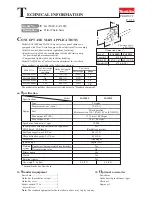
English
12
MAINTENANCE AND INSPECTION OF SAW BLADE
MOUNT
(1) After use, blow away sawdust, earth, sand, moisture,
etc., with air or brush them away with a brush, etc.,
to ensure that the blade mount can function
smoothly.
(2) As shown in
Fig. 13
, carry out lubrication around
the blade holder on a periodic basis by use of
cutting fluid, etc.
NOTE
Continued use of the tool without cleaning and
lubricating the area where the saw blade is installed
can result in some slack movement of the lever due
to accumulated sawdust and chips. Under the
circumstances, pull a rubber cap provided on the
lever in the direction of an arrow mark as shown
in
Fig. 14
and remove the rubber cap from the lever.
Then, clean up the inside of the blade holder with
air and the like and carry out sufficient lubrication.
The rubber cap can be fitted on if it is pressed firmly
onto the lever. At this time, make certain that there
exists no clearance between the blade holder and
the rubber cap, and furthermore ensure that the
saw-blade-installed area can function smoothly.
3. Moving the base
Loosen the hex. socket bolt with hexagonal bar
wrench and move the base forward, as shown in
Fig. 15, Fig. 16
. Tighten the set screw slightly,
ensure the base does not move back and forth, and
firmly tighten the hex. socket bolt. Ensure that the
base does not contact the blade.
4. Confirm that the battery is mounted correctly
HOW TO USE
How to make the batteries perform longer
䡬
Recharge the batteries before they become
completely exhausted.
When you feel that the power of the tool becomes
weaker, stop using the tool and recharge its battery.
If you continue to use the tool and exhaust the
electric current, the battery may be damaged and
its life will become shorter.
CAUTION
䡬
Do not carry tools with your finger on the switch.
A sudden startup can result in an unexpected injury.
䡬
Be careful not to let sawdust, earth, moisture, etc.,
enter the inside of the machine through the plunger
section during operation. If sawdust and the like
accumulate in the plunger section, always clean it
before use (refer to
Fig. 6
).
䡬
During use, press the base against the material
while cutting.
Vibration can damage the saw blade if the base is
not pressed firmly against the workpiece.
Furthermore, a tip of the saw blade can sometimes
contact the inner wall of the workpiece, damaging
the saw blade.
䡬
Select a saw blade of the most appropriate length.
Ideally, the length protruding from the base of the
saw blade after subtracting the stroke quantity should
be larger than the material (see
Fig. 18
).
If you cut a large block of wood, etc., that exceeds
the cutting capacity of a blade; there is a risk that
the blade may contact with the inner wall of the
wood, etc., resulting in damage (
Fig. 19
).
䡬
To extend the lifetime, the lithium-ion battery equips
with the protection function to stop the output.
Therefore, if the tool is overloaded, the motor may
stop. However, this is not the trouble but the result
of protection function. In this case, release the switch
of tool and eliminate the causes of overloading.
1. Switch operation
(1) Lock-off button
The tool is equipped with a lock-off button. To
activate the trigger lock, move the button to the
right position. Move the button to the left to operate
the tool (
Fig. 17
).
Always lock the switch when carrying or storing the
tool eliminate unintentional starting.
(2) Trigger switch
This tool is equipped with a variable speed controlled
trigger switch. The tool can be turned "ON" or "OFF"
by squeezing or releasing the trigger. The blade
plunger stroke rate can be adjusted from the
minimum to maximum nameplate stroke rate by
the pressure you apply to the trigger. Apply more
pressure to increase the speed and release pressure
to decrease speed.
2. Using the light
Pull the trigger switch to light up the light. The light
keeps on lighting while the trigger switch is being
pulled. The light goes out after releasing the trigger
switch. (
Fig. 4
)
CAUTION
Do not look directly into the light. Such actions
could result in eye injury.
3. Cutting lumber
When cutting lumber, make sure that the workpiece
is fastened firmly before beginning (
Fig. 20
).
CAUTION
䡬
Never apply any unreasonable force to the saw
blade when cutting. Also remember to press the
base against the lumber firmly.
䡬
Delay the feed speed when cutting the material into
small circular arcs. An unreasonably fast feed may
break the blade.
4. Cutting metallic materials
CAUTION
䡬
Press the base firmly against the workpiece.
䡬
Never apply any unreasonable force to the saw
blade when cutting. Doing so can easily break the
blade.
䡬
The motor can be locked sometimes, depending on
the combination of the material to be cut and the
blade. Whenever the motor gets locked, switch it
off immediately.
(1) Fasten a workpiece firmly before operation (
Fig. 21
).
(2) When cutting metallic materials, use proper machine
oil (turbine oil, etc.). When not using liquid machine
oil, apply grease over the workpiece.
CAUTION
The service life of the saw blade will be drastically
shortened if you don’t use machine oil.
5. Plunge cutting
With this tool, you can perform plunge cutting on
plywood panels and thin board materials. You can
01Eng_CJ10DL_EE
7/24/09, 17:46
12














































